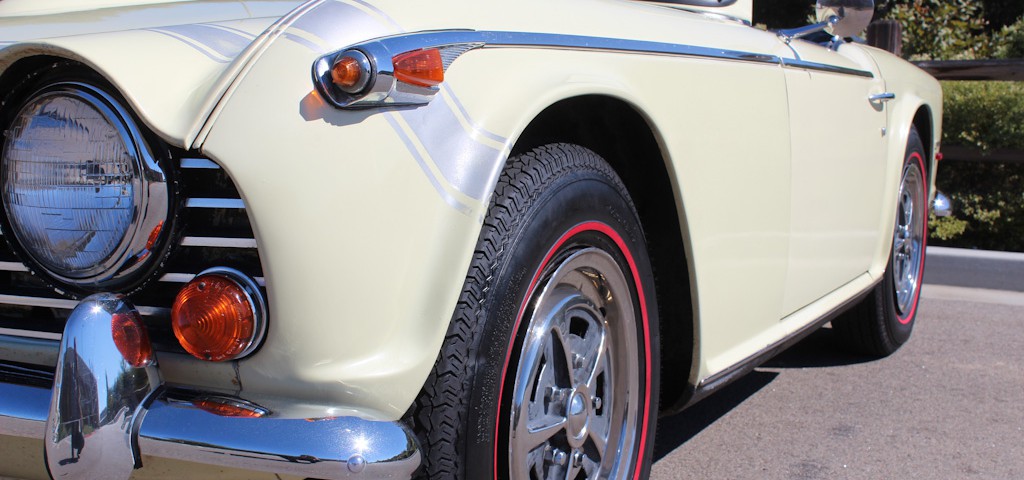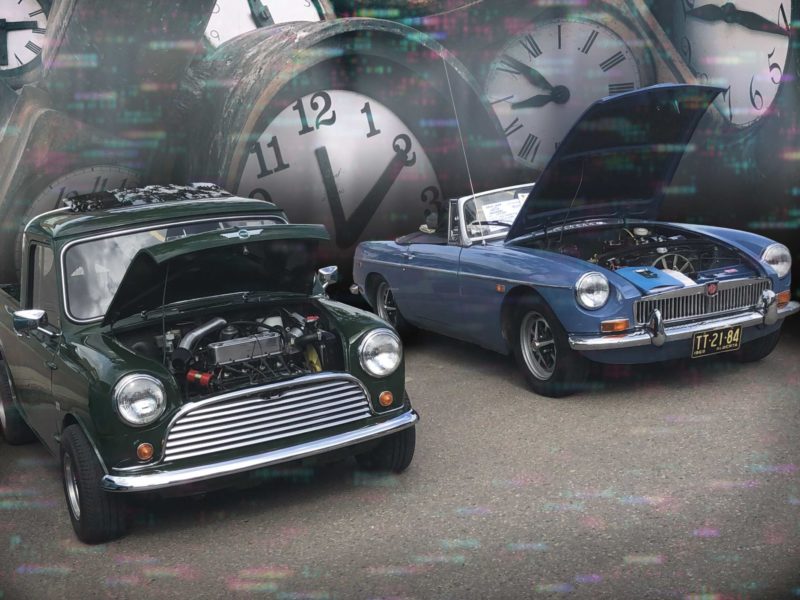Despite the success of the Triumph TR4 and TR4A in sales and competition, as the end of the 60s approached it was clear that the company had to improve its performance with the introduction of a new engine that could offer not only greater horsepower, but also smoother operation than the relatively rough and noisy 4-cylinder could provide. The answer would lie with the 1998-cc inline 6-cylinder engine from the Triumph 2000 sedan, which was stroked to 2498-cc for use in the Triumph TR250 and TR5.
Management had determined that the new powerplant would have to make 150 hp to provide the desired top speed of 120 mph and sub-nine second times from 0-60 mph, but the only practical means of doing so would require installation of the new Lucas PI fuel-injection system that would make its debut in the TR5. So equipped, the TR5 became the first mass-produced fuel injected British car and was the most affordable 120-mph vehicle in the country as well. With the exception of the new engine, the only external differences were a slightly revised grill with painted slats and new marker lights and chrome trim. Inside, a matte finish replaced the polished surface on the walnut dash while new seats debuted that were the most comfortable yet seen in a TR.

Now considered the most attractive of the four Triumph string eras – sidescreen, Michelotti, Karmann and Wedge – the shape pioneered by the TR4 combined with the grunt from the 6-cylinder engine is a winning combination
Alas, despite the impressive performance that the fuel-injection made possible, restrictive emissions rules in the United States made sale of the TR5 impossible because the primitive nature of the Lucas system could not meet the Federal standards. What this meant was that while the UK and continental Europe would enjoy the fastest TR ever built, the United States would get the Triumph TR250, which featured the same six-cylinder engine fed through dual tamper-proof Zenith-Stromberg carburetors that forced use of mild cam timing – compared to the TR5 – that resulted in only 104 hp at 4500 rpm – the same output as the 4-cylinder engine in the TR4A – but increased torque to the tune of 143 ft/lbs at 3000 rpm to allow for only slightly better acceleration and top speed. While response to the TR5 was enthusiastic – “without doubt the best Triumph yet” declared Autosport – in the United States, enthusiasm for the new model was decidedly muted, with Car & Driver musing, “to pay an extra $500 for a nearly identical but slower car doesn’t make much sense.” To be fair, the TR250 was much smoother and quieter than the TR4A and Road & Track found that the new engine “could hardly run more sweetly” and changed the essence of the TR from rough and tumble to relaxed and smooth.

The seats – unique to the TR250 – are the most comfortable and provide the most room of any TR from TR2 through TR6
For all the negativity that the TR250 engendered during its brief production run – only 14 months – it is appreciated now for having combined the best elements of the TR4 with the performance potential offered by the TR6. Modern advancements and technological know-how make it possible for current owners to replicate the 150-hp TR5 with the existing carbureted setup and for these reasons and others, the TR250 is now the most valuable TR sold in America.
Driven
The lines of the TR250 have only improved with time and the Michelotti design has an elegance that is lacking in both the TR3 and TR6 and despite having a wheelbase that is 3-inches shorter than the MGB with slightly more overall length, it appears to be the more substantial car. The muted tailfins, higher fender lines and larger 15-inch wheels add to that impression, although both cars are comparable in overall height. The interior of the TR250 is more luxurious than any offered by its competitors with its polished walnut dash, leather seats and high quality carpeting. The seats are comfortable and the travel adjusted such that any sized driver can be easily accommodated within, while the three-spoke steering wheel is both attractive to look at and well positioned for use. It would be hard to improve upon the basic instrumentation package that was largely carried over from the TR2. The face-level vents are a nice touch along with the generously sized lockable glove box that is situated before the passenger. The occasional rear seat provides a flat surface upon which soft luggage can be placed since it is no longer legal to place unbelted passengers in the diminutive space.

The Rostyle wheels and racing stripe are period touches that mark the TR250 as another matter from its TR4A predecessor
The engine starts with a turn of the key and it springs to idle with a growl reminiscent of a Big Healey. The pedal box is large enough that the dimmer switch – located on the floor adjacent to the driver’s kick panel – can be used as a dead pedal provided the driver is careful not to engage the switch with a heavy foot. The accelerator and brake pedal are closely located to allow for easy heel-and-toe operation and the clutch effort required for engagement is light enough to use the car in heavy traffic without much complaint. The gearbox – an all-synchromesh unit – is a delight to use although it is best used slowly – with a slight pause in the neutral position – to provide the smoothest shifts. The lever itself is short and well placed as it falls easily to hand from the steering wheel. Steering effort is very light and the slightest turns will result in a change of direction so it is best to let the car self-steer – with only a light hand on the wheel – down the freeway or long stretches of straight roads.
The exhaust note is loud and powerful although unobtrusive at moderate speeds. The engine will pull strongly up to the redline and has the ability to cruise all day at 80 mph without fear of damaging any internal components given its stout construction. There is enough torque to remind you how much fun driving can be and the power band is tractable from idle to 5000 rpm. As much fun as an Austin-Healey 3000 or Jaguar E-Type, the IRS suspension provides a supple ride that easily handles irregular road surfaces with aplomb.
Sampled – It’s hard to believe that the TriumphTR250 was once unloved by even Triumph enthusiasts, but that train has long ago left the station, as it is now the most sought after of the TRs sold in America. The example that we were provided by Chequered Flag International in Marina Del Rey, California is the most original that we have ever seen with only one owner from new until 2014. Restored cars – no matter how much time and money is thrown at them – will never match the driving feel of an original car and this TR250 bears that out. More solid than any other example that we’ve driven, it was much as it must have been when first sold, a delightful roadster with added torque over the TR4A to play with in the twisty bits. With fewer made than any other TR, they’re hard to find but well worth seeking out.









'Driven – 1968 Triumph TR250' has no comments
Be the first to comment this post!